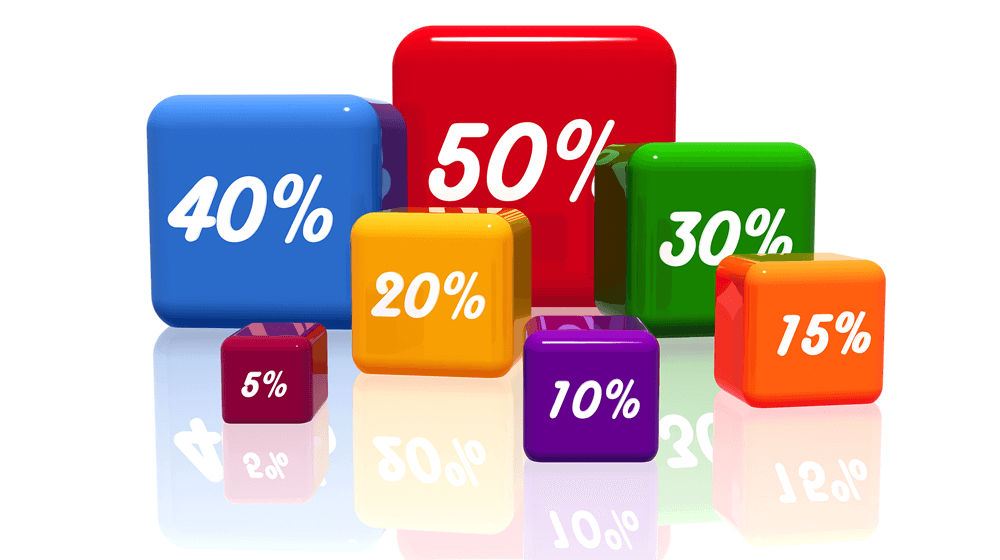
A sales commission rate is a percentage of the sales your small business pays to the employee who made them. Here’s an example. If your small business sets a commission rate of 5% and an individual on the sales team makes $70,000 in net sales, the formula works like this:
$70,000 (net sales) x 5% (commission rate) = $3500 (payable to salesperson)
Why You Need Sales Commission Rates
There are a few different reasons why it’s a good idea to have sales commission rates for your small business. A sales commission rate can allow for different compensations for different levels of sales to increase motivation.
These also clearly define how people are compensated for their efforts. Small businesses can set rates for full-time and outsourced salespeople so everyone is on the same page. They can be fixed or on a series of sliding scales like in the following example.
Let’s say that you pay someone on the sales team 5% for every unit up to $100,000. With a tiered commission plan that rate could go up to 7% once the plateau of $100,000 is reached and surpassed.
The sales commission rate playbook has a lot of choices. Here are a few ways to start thinking about how to set one that makes sense for your small business.
Different Ways to Set Them
While you can set your own rates, there are a few different scenarios that you might want to consider if you don’t already have a sales commission rate in place.
For example, small businesses might want to consider a lower commission rate if they have an inside sales team that works from a set list for cold calls. If a sales rep has a list of prospects to get in touch with, you might want to consider a base salary to offset a lower commission rate since the closing rate might be low.
Commissions for Different Kinds of Sales Teams
Sales teams that are focusing on building relationships one at a time should consider a commission rate that takes into account individual sales. This works great for outside sales teams who are meeting people face-to-face.
If you’re thinking big picture even though you’re a small business, setting a commission rate based on volume by territory is the best way to go here.
Finding the Sweet Spot
Finding the sweet spot for this sales commission rate can be helped along when you make these territories protected. It’s a great way to prevent poaching and keeps all the sales reps motivated but in their own territorial lanes.
Sometimes there’s a difference in the commission rate depending on what you sell. Small businesses that sell services are more likely to offer a percentage of the net profits than manufacturing outfits.
Finally, some companies will pay a larger commission rate and even bonuses for bringing in new clients or breaking into and forming new territories.
Mixing a Base Salary with your Commission Rate
Small businesses also have the option of mixing a base salary with the commission rate. You’ll need to decide if your sales people are the major drivers of getting your goods and services sold. If the answer is yes, you’ll need to have a higher rate.
On the other hand, if your goods and services pretty much sell themselves and your sales people lean more towards customer service, providing them with more of a salary is a good idea.
Finding Some Benchmarks to Gauge
Of course, it’s helpful to have some benchmarks to gauge your sales commission rates by. If you want to attract the best talent for your small business, it’s a good idea to stay in the ballpark that was set by other people in the same industry.
Salespeople in the services industries generally make a higher commission rate then those who sell manufactured products. In fact, research shows they can make between 20 to 40% commission.
Keeping Rates Low for Manufactured Goods
The price of building products including the overhead keeps the commission rate down for salespeople who are working with manufactured goods. The ballpark here is around 9 to 10% for these salespeople.
More numbers indicate that the low-end equals out to about $50,000 a year with the top end peaking at $75,000 on average.
Considering These Specifics
Specifically, the going sales commission rate for storm restoration and roofing businesses is around 10%. Home improvement sales reps generally make the same. Pest control salespeople make as much is 25% on the sales they make.
Marketing people can make as much as 20% on the first payment from a client. Sometimes, this can drop back down to around 10% as the payments continue.
Remember, these are only examples. Most small businesses will want to set their own rates based on the information that’s being provided here and their own business model.
Looking for Help when Possible
With everything else that you have to do is a small business owner, finding the time to set the right sales commission rate might sit on a ‘to do’ list longer than you’d like. Technology can be a real help. GetApp has a great list of some of the most updated software options.
If you are already tech savvy as a small business owner, you might be using accounting software. If that’s the case you can find some templates for setting sales commission rates with some of the services you already use. Check out QuickBooks Apps. Their Easy-Commission app calculates customized commission rates for each rep.
Image: Depositphotos.com
This article, "How to Turn your Sales Commission Rates from Blah to Fantastic" was first published on Small Business Trends
No comments:
Post a Comment